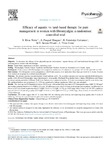Mostrar o rexistro simple do ítem
Efficacy of aquatic vs land-based therapy for pain management in women with fibromyalgia: a randomised controlled trial
| dc.contributor.author | Ribas Neira, Sabela | |
| dc.contributor.author | Pasqual Marques, Amelia | |
| dc.contributor.author | Fernández-Cervantes, Ramón | |
| dc.contributor.author | Seoane-Pillado, Teresa | |
| dc.contributor.author | Vivas-Costa, Jamile | |
| dc.date.accessioned | 2024-05-20T06:07:39Z | |
| dc.date.available | 2024-05-20T06:07:39Z | |
| dc.date.issued | 2024-03-05 | |
| dc.identifier.citation | Rivas Neira S, Pasqual Marques A, Fernández Cervantes R, Seoane Pillado MT, Vivas Costa J. Efficacy of aquatic vs land-based therapy for pain management in women with fibromyalgia: a randomised controlled trial. Physiotherapy. 2024;123:91-101. | es_ES |
| dc.identifier.issn | 0031-9406 | |
| dc.identifier.uri | http://hdl.handle.net/2183/36518 | |
| dc.description.abstract | [Abstract] Objective. To determine the efficacy of two physiotherapeutic interventions – aquatic therapy (AT) and land-based therapy (LBT) – for reducing pain in women with fibromyalgia. Design. Single-blind, randomised controlled, equivalence trial. Setting. Fibromyalgia, Chronic Fatigue Syndrome and Multiple Chemical Sensitivity Association in A Coruña, Spain. Participants. Forty women with fibromyalgia were assigned at random in a 1:1 manner to two groups: AT (n = 20) and LBT (n = 20). Interventions. Two therapeutic exercise programmes, with 60-min sessions, were undertaken three times per week for 12 weeks. Sessions were carried out in groups by a trained physiotherapist. Outcome. The primary outcome was pain intensity (visual analogue scale). The secondary outcomes were pressure pain threshold (algometer), quality of life (Revised Fibromyalgia Impact Questionnaire), sleep quality (Pittsburgh Sleep Quality Index), fatigue (Multidimensional Fatigue Inventory) and physical ability (6-Minute Walk Test). Patients were evaluated at baseline, 12 weeks (post-treatment) and 18 weeks (follow-up). The statistical analysis was per-protocol. P < 0.05 was considered to indicate significance. Effect size was calculated. Results. The mean age was 50 [standard deviation (SD) 9] years, with median body mass index of 27 [interquartile range (IQR) 25–30] kg/m2 and median symptom duration of 11 (IQR 6–15) years. No differences were observed between the groups post-treatment, but differences in favour of AT were found in pain intensity [2.7 (IQR 1.5-4.9) vs 5.5 (IQR 3.3-7.6); p= 0.023; large effect, Cohen's d= 0.8; 95% confidence interval (CI) 0.1-1.5] and sleep quality [12.0 (IQR 7.3-15.3) vs 15.0 (IQR 13.0-17.0); p= 0.030; large effect, Cohen's d= 0.8; 95% CI 0.1-1.5] at follow-up. Conclusions. The results suggest that AT is better than LBT for reducing pain intensity and improving sleep quality after 6 weeks of follow-up. AT may be a good treatment option for women with fibromyalgia. | es_ES |
| dc.language.iso | eng | es_ES |
| dc.publisher | Elsevier | es_ES |
| dc.relation.uri | https://doi.org/10.1016/j.physio.2024.02.005 | es_ES |
| dc.rights | Creative Commons Attribution-NonCommercial-NoDerivs 4.0 International License (CC-BY-NC-ND 4.0) | es_ES |
| dc.rights.uri | http://creativecommons.org/licenses/by-nc-nd/4.0/ | |
| dc.subject | Fibromyalgia | es_ES |
| dc.subject | Physiotherapy | es_ES |
| dc.subject | Aquatic therapy | es_ES |
| dc.subject | Exercise therapy | es_ES |
| dc.subject | Pain | es_ES |
| dc.subject | Sleep quality | es_ES |
| dc.title | Efficacy of aquatic vs land-based therapy for pain management in women with fibromyalgia: a randomised controlled trial | es_ES |
| dc.type | info:eu-repo/semantics/article | es_ES |
| dc.rights.access | info:eu-repo/semantics/openAccess | es_ES |
| UDC.journalTitle | Physiotherapy | es_ES |
| UDC.volume | 123 | es_ES |
| UDC.startPage | 91 | es_ES |
| UDC.endPage | 101 | es_ES |
| dc.identifier.doi | 10.1016/j.physio.2024.02.005 |
Ficheiros no ítem
Este ítem aparece na(s) seguinte(s) colección(s)
-
GI-IPRF - Artigos [140]






